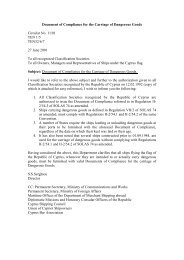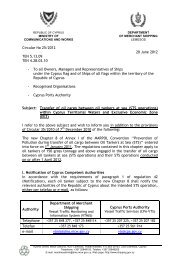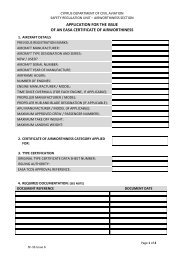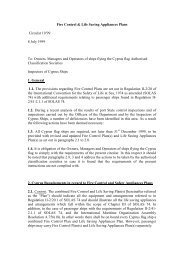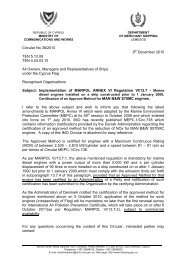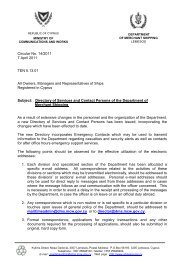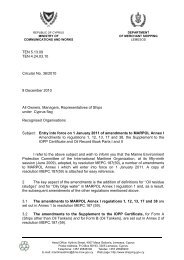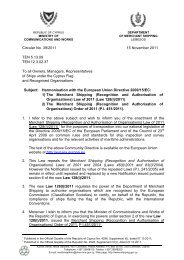REPUBLIC OF CYPRUS A I C
REPUBLIC OF CYPRUS A I C
REPUBLIC OF CYPRUS A I C
You also want an ePaper? Increase the reach of your titles
YUMPU automatically turns print PDFs into web optimized ePapers that Google loves.
PHONE: (357) 22404184<br />
(357) 24802925<br />
AFTN: LCNCYNYX<br />
TELEX: 6065 CIVAIR CY<br />
FAX: (357) 22404189<br />
SITA:<br />
NICTOYA<br />
<strong>REPUBLIC</strong> <strong>OF</strong> <strong>CYPRUS</strong><br />
MINISTRY <strong>OF</strong> COMMUNICATIONS AND<br />
WORKS<br />
DEPARTMENT <strong>OF</strong> CIVIL AVIATION<br />
AERONAUTICAL INFORMATION SERVICE<br />
NICOSIA <strong>CYPRUS</strong><br />
A I C<br />
C 15/2007<br />
14 November<br />
GENERAL<br />
ISSUE <strong>OF</strong> AN EASA PERMIT TO FLY<br />
A Permit to Fly is issued by the Department of Civil Aviation, Safety Regulation Unit or by an<br />
organisation that has an EASA Part 21 Production or Design approval with privileges to issue such<br />
a Permit. It is generally issued when a certificate of airworthiness is temporarily invalid, for<br />
example as the result of damage, or when a certificate of airworthiness cannot be issued. These are<br />
the instances when the aircraft does not comply with the essential requirements for airworthiness or<br />
when compliance with those requirements has not yet been shown, but the aircraft is nevertheless<br />
capable of performing a safe flight.<br />
Permits to fly shall be issued in accordance with EASA Part 21, Subpart P under defined conditions<br />
and for the following purposes:<br />
• Development;<br />
• Showing compliance with regulations or certification specifications;<br />
• Design organisations or production organisations crew training;<br />
• Production flight testing of new production aircraft;<br />
• Flying aircraft under production between production facilities;<br />
• Flying the aircraft for customer acceptance;<br />
• Delivering or exporting the aircraft;<br />
• Flying the aircraft for DCA acceptance;<br />
• Market survey, including customer’s crew training;<br />
• Exhibition and air show;<br />
• Flying the aircraft to a location where maintenance or airworthiness review are to<br />
be performed, or to a place of storage;<br />
• Flying an aircraft at a weight in excess of its maximum certificated takeoff weight<br />
for flight beyond the normal range over water, or over land areas where adequate<br />
landing facilities or appropriate fuel is not available;<br />
• Record breaking, air racing or similar competition;<br />
• Flying aircraft meeting the applicable airworthiness requirements before<br />
conformity to the environmental requirements has been found;<br />
• For non-commercial flying activity on individual non-complex aircraft or types for<br />
which a certificate of airworthiness or restricted certificate of airworthiness is not<br />
appropriate (orphan aircraft).<br />
In order for a Permit to Fly to be approved by the Department, an approval of the flight conditions<br />
must be obtained. Flight conditions are approved by EASA when this approval is related to the<br />
safety of the design. In all other cases the flight conditions are approved by the Department. Flight<br />
conditions can also be approved by an organisation that has an EASA Part 21 Production or Design<br />
approval with privileges to approve such conditions<br />
1
Flight conditions include:<br />
a) The configuration(s) for which the permit to fly is requested;<br />
b) Any condition or restriction necessary for safe operation of the aircraft, including:<br />
• The conditions or restrictions put on itineraries or airspace, or both, required for the<br />
flight(s);<br />
• The conditions and restrictions put on the flight crew to fly the aircraft;<br />
• The restrictions regarding carriage of persons other than flight crew;<br />
• The operating limitations, specific procedures or technical conditions to be met;<br />
• The specific flight test programme (if applicable);<br />
• The specific continuing airworthiness arrangements including maintenance<br />
instructions and regime under which they will be performed;<br />
c) The substantiation that the aircraft is capable of safe flight under the conditions or<br />
restrictions of subparagraph (b);<br />
d) The method used for the control of the aircraft configuration, in order to remain within<br />
the established conditions.<br />
PROCEDURE WHEN THE APPROVAL <strong>OF</strong> FLIGHT CONDITIONS IS RELATED TO<br />
THE SAFETY <strong>OF</strong> THE DESIGN<br />
Examples of flight conditions, the approval of which is related to the safety of design are when:<br />
• The aircraft does not conform to an approved design<br />
• An Airworthiness Limitation, a Certification Maintenance Requirement or an<br />
Airworthiness Directive has not been complied with<br />
• The intended flight(s) are outside the approved envelope<br />
The applicant must apply for approval of such flight conditions directly to EASA, using EASA<br />
Form 37. This form can be downloaded from the EASA website,<br />
http://www.easa.europa.eu/home/c_permittofly.html, or obtained from the Safety Regulation Unit<br />
of the Department.<br />
EASA will approve the flight conditions and return EASA Form 18B to the applicant. The<br />
applicant must submit this form together with an application for an EASA Permit to Fly, EASA<br />
(DCA) Form 21, to the Department.<br />
Establishing compliance with the conditions of an EASA Permit to fly will require either direct<br />
inspection of the aircraft by the Department or certification and issue of a Flight Release Certificate<br />
by an authorised person.<br />
If a Flight Release Certificate is to be issued, the Standard Form SF-50 Flight Release Certificate<br />
document shall be used.<br />
The Flight Release Certificate can only be issued by the following persons<br />
• The holder of a Part 66 licence appropriately endorsed for the aircraft type<br />
• The holder of an ICAO Annex 1 maintenance engineers licence that has been<br />
validated by the DCA<br />
• The holder of a valid and appropriate authorisation issued by an organisation<br />
approved under Part 145 and in accordance with the terms of the authorisation.<br />
• The holder of a valid and appropriate authorisation issued by an organisation<br />
approved under Part 21 and in accordance with the terms of the authorisation.<br />
• A person authorised / approved by the DCA as being competent to issue such<br />
certification in a particular case.<br />
2
The validity of the Flight Release Certificate must be stated and shall not exceed 14 days. If the<br />
airworthiness condition of the aircraft is changed during the period of validity, the certificate shall<br />
be re-issued. Each certificate shall be issued in duplicate, one copy must go on the aircraft, and the<br />
other retained in the aircraft’s technical records.<br />
Any maintenance performed on the aircraft whilst operating on a Permit to Fly, with the exception<br />
of a pre-flight inspection, will require the issue of a Certificate of Release to Service.<br />
PROCEDURE WHEN THE APPROVAL <strong>OF</strong> FLIGHT CONDITIONS IS NOT RELATED<br />
TO THE SAFETY <strong>OF</strong> THE DESIGN<br />
Examples of flight conditions, the approval of which is not related to the safety of design are when:<br />
• Production flight testing for the purpose of conformity establishment<br />
• Delivery / export flight of a new aircraft, the design of which is approved<br />
• Positioning flights for maintenance when the Certificate of Airworthiness has<br />
expired<br />
• Flights to a place of storage or to a place where maintenance or painting is carried<br />
out<br />
• Flights necessary for the issue or re-validation of a Certificate of Airworthiness of<br />
an already approved design<br />
The applicant must apply for approval of such flight conditions directly to the Department, using<br />
EASA (DCA) Form 37. The applicant must submit this form together with an application for an<br />
EASA Permit to Fly, EASA (DCA) Form 21, to the Safety Regulation Unit.<br />
Establishing compliance with the conditions of an EASA Permit to fly will require either direct<br />
inspection of the aircraft by the Department or certification and issue of a Flight Release Certificate<br />
by an authorised person.<br />
If a Flight Release Certificate is to be issued, the Standard Form SF-50 Flight Release Certificate<br />
document shall be used.<br />
The Flight Release Certificate can only be issued by the following persons<br />
• The holder of a Part 66 licence appropriately endorsed for the aircraft type<br />
• The holder of an ICAO Annex 1 maintenance engineers licence that has been validated<br />
by the DCA<br />
• The holder of a valid and appropriate authorisation issued by an organisation approved<br />
under Part 145 and in accordance with the terms of the authorisation.<br />
• The holder of a valid and appropriate authorisation issued by an organisation approved<br />
under Part 21 and in accordance with the terms of the authorisation.<br />
• A person authorised / approved by the DCA as being competent to issue such<br />
certification in a particular case.<br />
The validity of the Flight Release Certificate must be stated and shall not exceed 14 days. If the<br />
airworthiness condition of the aircraft is changed during the period of validity, the certificate shall<br />
be re-issued. Each certificate shall be issued in duplicate, one copy must go on the aircraft, and the<br />
other retained in the aircraft’s technical records.<br />
Any maintenance performed on the aircraft whilst operating on a Permit to Fly, with the exception<br />
of a pre-flight inspection, will require the issue of a Certificate of Release to Service.<br />
3
CHANGES<br />
Any change that invalidates the flight conditions or associated substantiation established for the<br />
Permit shall be approved by the DCA. When relevant, an application shall be made. A change<br />
affecting the content of the Permit requires the issuance of a new Permit.<br />
OPERATIONAL REQUIREMENTS<br />
An EASA Permit to Fly issued under EU regulations is valid in all EU member states, however<br />
national operational requirements remain applicable. Any person conducting a flight in an aircraft<br />
operating on a Permit to Fly must ensure that they comply with any operational requirements<br />
applicable to such aircraft for the airspace they are using (if any). Applicants should consult with<br />
relevant National Authorities in case of doubt.<br />
4



